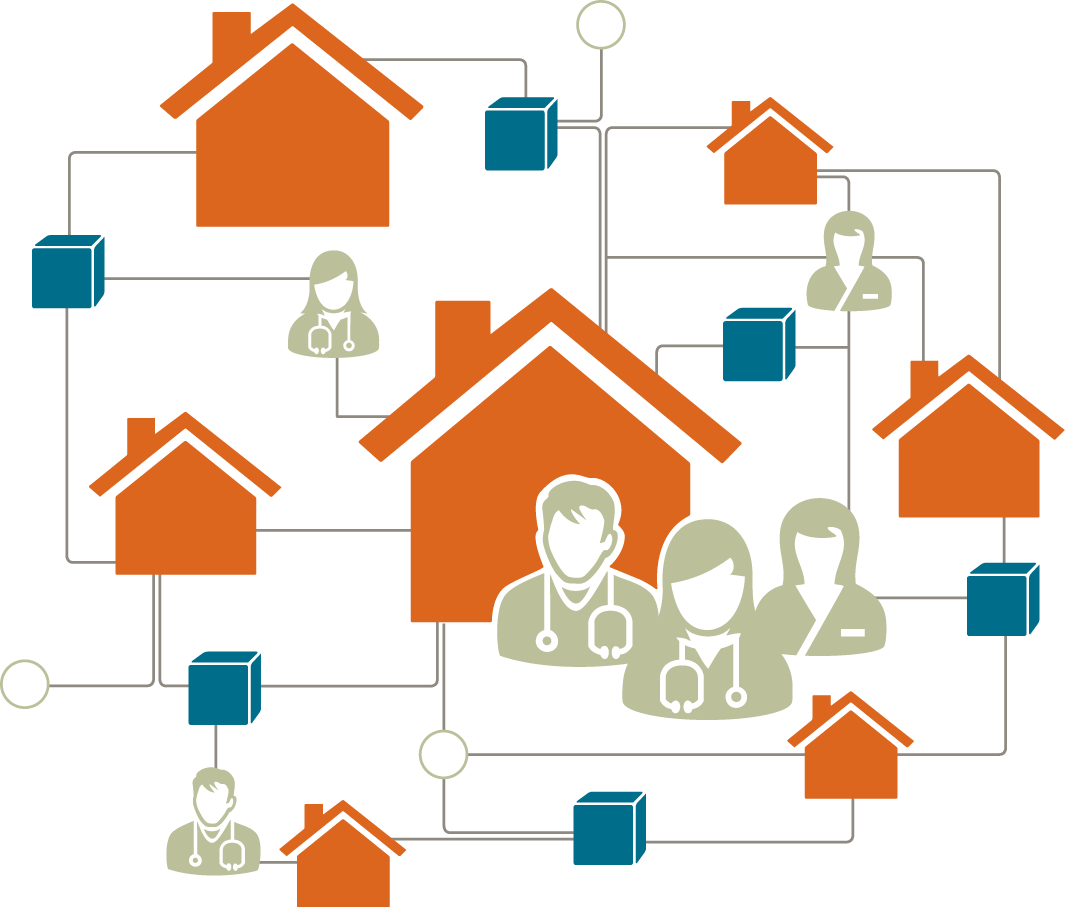Participate in a supportive network of local primary care services to increase comprehensive care.
Across BC, divisions of family practice, the five regional health authorities, the First Nations Health Authority, First Nations, and community partners are working to establish primary care networks (PCNs).
Read about the refreshed primary care network (PCN) approach, announced August 22, 2023.
A PCN is a clinical network of local primary care service providers located in a geographical area, with patient medical homes (PMHs) as the foundation. A PCN is enabled by a partnership between a local division of family practice, their regional health authority, local First Nations, and other community partners.
In a PCN, physicians, nurse practitioners, nurses, allied health care providers, health authority service providers, local First Nations, and community organizations work together to provide all the primary care services a local population requires. Together, they:

- Enhance patient care using a team-based approach to care.
- Support each other and work to their own strengths.
- Ensure patients are linked to other parts of the system, including the health authority’s specialized community services programs for high risk and vulnerable population groups.
- Collectively work to increase access and attachment to primary care.
Participation in a primary care network helps patient medical homes operate at their full potential. A PCN aspires to provide patients with access to timely, comprehensive, and coordinated team-based care, guided by eight core attributes.
PCN Core Attributes:
- Access and attachment to quality primary care.
- Extended hours.
- Same day access to urgent care.
- Advice & information.
- Comprehensive primary care.
- Culturally safe care.
- Coordinated care.
- Clear communication.
When participating in a PCN, family physicians can:
- Provide optimal care for patients with the support of teams, and easily accessed health authority services.
- Access expanded services for vulnerable populations and those with complex health conditions.
Get involved
For more information about the primary care network in your community, please contact your local division of family practice. For all general inquiries please contact pcn@doctorsofbc.ca.
How do PCNs work?
A PMH represents the work in the doctor’s office, while the PCN represents system change in the community. PCNs are governed by local PCN Steering Committees, which are led by physicians and make decisions by consensus. They bring together physicians, nurse practitioners, First Nations, patients, and community and health authority partners to collaboratively design primary health services that meet the community’s needs.
- Decisions about the local PCN are made by the local PCN Steering Committee, whose membership represents family doctors, other primary care providers from the community, and community advisory representatives.
- Working with their division, family doctors are integral in designing and influencing how local PCNs support patients.
- Physician leadership and division participation is essential to establish PCNs as the foundation of an integrated system of care.
Creating PCNs across BC
Across the province, collaborative services committees (CSCs) established PCNs by building on successful local initiatives. CSC partners completed expressions of interest (EOI) and those who were approved received change management funding and other supports to develop service plans to address their local primary care needs.
Collaborative services committees (CSCs) are encouraged to focus their first phase of service planning on ensuring patients who do not have a primary care provider are attached to one. Once the attachment gap is narrowed, the focus is on redesigning local services and adding resources to optimize the team-based care approach.
Following approval of the Service Plan, CSCs are provided with funding to establish a PCN Steering Committee, hire staff, and begin implementation.
BC Communities involved in PCNs
Ninety-five PCNs have approved funding allocations and are now implementing their service plans:
- Fraser | Burnaby (4), Abbotsford (3), Chilliwack (3), Fraser Northwest (4), Langley (3), Mission (1), Ridge Meadows (2), Surrey-North Delta (6), South Delta (1), White Rock-South Surrey (1).
- Vancouver Coastal | North Shore (3), qathet (1), Richmond (3), Sea to Sky (2), Sunshine Coast (1), Vancouver (6).
- Island | Campbell River (1), Central Island - Oceanside (1), Central Island – Port Alberini (1), Comox Valley (1), Cowichan Valley (1), Nanaimo (2), Rural & Remote - Gabriola Island (1), Rural & Remote - Long Beach (1), South Island - Salt Spring Island (1), South Island - Saanich Peninsula (1), South Island - Western Communities (1), Victoria (4).
- Interior | Central Interior Rural (1), Central Okanagan (3), East Kootenay (1), Kootenay Boundary (1), Shuswap North Okanagan (2), South Okanagan Similkameen (1), Thompson Region (2).
- Northern | North Peace (1), Northern Interior Rural (7*), Pacific Northwest - Bulkley Valley Witset (2), Pacific Northwest – Coast Mountain (4), Pacific Northwest – Haida Gwaii (2), Pacific Northwest – Kitimat / Haisla (1), Pacific Northwest - Prince Rupert (1), Prince George (1), Rural & Remote - Hazelton (1), South Peace (3).
There are several additional regions and communities in various stages of PCN engagement and planning.
Updated April 11, 2024
